Author: Steve Crum
‘Heretic’ terrifies as house of horrors tale starring well spoken, lethal Hugh Grant
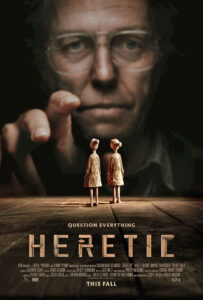 By Steve Crum
By Steve Crum
Of the dozens and dozens of movies about haunted houses ever produced, there are some standouts. (I am not counting the comedy hh movies, led by The Ghost and Mr. Chicken.) Still scary are House on Haunted Hill, The Amityville Horror, and The Others. The best of the bunch remains a tie between 1963’s atmospheric The Haunting and 1944’s The Uninvited.
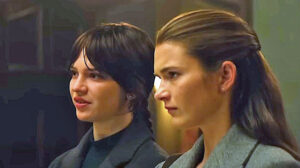 Now we have 2024’s Heretic, a foreboding horror movie co-directed and written by Scott Beck and Bryan Woods. The duo have restructured the standard haunted house formula with the violence of Saw. Then add a huge dose of faith elements.
Now we have 2024’s Heretic, a foreboding horror movie co-directed and written by Scott Beck and Bryan Woods. The duo have restructured the standard haunted house formula with the violence of Saw. Then add a huge dose of faith elements.
As opposed to Beck and Woods’ 2018 horror hit, the well named A Quiet Place, Heretic is packed with 111 minutes of nearly nonstop sounds of religious discussion (mainly by Hugh Grant’s character), as well as creaks, moans and screams. (Cue the sound effects!)
Mr. Reed (Grant) is the heretic of the title, a guy who claims he has studied Christianity and other religions. Yet he lives alone in this secluded old mansion, unable to discuss his knowledge. It turns out to be extremely biased “knowledge.” He yearns to share what he has learned with the front 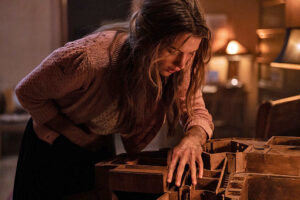 that he is interested in Mormonism. Naturally, Mr. Reed requests the Church of Jesus Christ of Latter-day Saints to send a couple of missionaries to his home. In quick time, the two missionaries, Sister Barnes (Sophie Thatcher) and Sister Paxton (Chloe East), are knocking at his door…at sundown on a rainy, windy day.
that he is interested in Mormonism. Naturally, Mr. Reed requests the Church of Jesus Christ of Latter-day Saints to send a couple of missionaries to his home. In quick time, the two missionaries, Sister Barnes (Sophie Thatcher) and Sister Paxton (Chloe East), are knocking at his door…at sundown on a rainy, windy day.
The two reluctantly come inside, even though Reed’s wife is nowhere to be seen. “She’s in the kitchen,” he says.
So begins a lethal game of wits, fear, and detective work on the part of the young ladies.
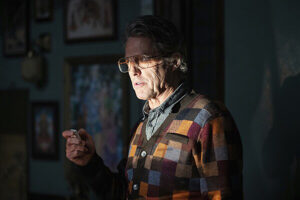 The story escalates into terror once it is discovered the front door is locked and now unusable. Creepy becomes CA-REEPY. The women are imprisoned.
The story escalates into terror once it is discovered the front door is locked and now unusable. Creepy becomes CA-REEPY. The women are imprisoned.
Prepare for their wild ride of making a “Lady or the Tiger” choice; Mr. Reed’s unending mind games; a visit from a cloaked prophet (?); and touring the house mazes. It is all familiar territory for a haunted house story, held together by the extraordinary work of Hugh Grant.
Who knew he could be so hellishly manipulative and controlling?
—————
GRADE on an A-F Scale: B-
‘Sing Sing’, headlined by Colman Domingo, features unique storyline
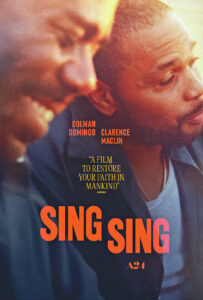 By Steve Crum
By Steve Crum
There has never been a prison movie like Sing Sing. However, Director-Screenscribe Greg Kwedar’s heartfelt drama perfectly fits within the sub-genre of American Prison Films. The traditional prison flick was established with 1930’s The Big House. (A year later, Laurel and Hardy hilariously parodied with Pardon Us.) Dozens of “Big House” stereotypes followed, including, egad, the wildly titled 20,000 Years in Sing Sing. More recent titles re-established the genre with Escape From Alcatraz and the widely regarded The Shawshank Redemption.
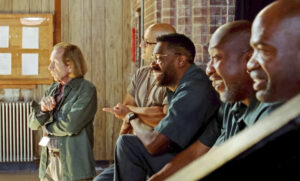
2024’s Sing Sing is cut from a different inmate cloth.
It looks and feels differently. Kwedar utilizes closer to a cinema vérité storytelling technique. In its documentary-reminiscent style, the focus is on stark characterizations rather than—say—planning for a breakout or violence involving the warden. The many facial closeups serve the purpose of knowing and caring about these cons.
The fact-based story’s main character is John “Divine G” Whitfield, brilliantly portrayed by Colman Domingo. He is an innocent man who has been wrongly found guilty of murder and now jailed at Sing Sing Correctional Facility (located in Ossining, NY). Divine G is also a driving force for the prison’s innovative RTA (Rehabilitation Through the Arts) Program. Plus he is the star actor and playwright. As such, he is the primary recruiter for new members to join the acting troupe. The very popular small group truly love 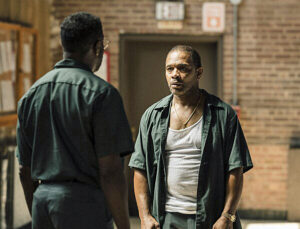 their theatrical work and regularly perform plays and cuttings by the likes of Shakespeare to Divine G. Add Brent Buell (Paul Raci) as a civilian who volunteers to direct and write many of the plays. Costuming, sound and lighting add to the mix. He works alongside Divine G. in getting the casting, rehearsals and presentations to the inmate population. This all occurs in the prison’s gymnasium, which includes a small stage.
their theatrical work and regularly perform plays and cuttings by the likes of Shakespeare to Divine G. Add Brent Buell (Paul Raci) as a civilian who volunteers to direct and write many of the plays. Costuming, sound and lighting add to the mix. He works alongside Divine G. in getting the casting, rehearsals and presentations to the inmate population. This all occurs in the prison’s gymnasium, which includes a small stage.
Running 105 minutes, Sing Sing’s drama balances the member recruiting, particularly regarding the reluctant Divine Eye (Clarence Maclin), with the personal challenges of cast members—like parole issues  and stage fright. It often feels like we are witnessing a play within a play. Yet that irony is so compelling and believable.
and stage fright. It often feels like we are witnessing a play within a play. Yet that irony is so compelling and believable.
Speaking of irony, most of the main cast members are actual former inmates at Sing Sing. That includes Maclin, who turns out to be a fine actor. And current convicts are seen as extras. The film itself becomes a rehabilitation influence. The cinema vérité technique also extends to the director’s use of a handheld 16mm camera; and utilizing Sing Sing and two other prisons as shooting locations. (The limited budget had much to do with those choices.)
Sing Sing is sensitive without being saccharine—sometimes elating, sometimes tearful. It deserves accolades.
—————
GRADE on an A-F Scale: A-
Colorful ‘Wicked’ explores Oz backstory, falling short
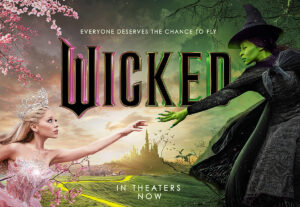 By Steve Crum
By Steve Crum
Although box office heralded, Wicked is troublesome as well as wondersome. At this writing, Wicked (aka Wicked: Part I) has just been Oscar nominated in multiple categories, including Best Picture. So what is “troublesome” about the movie? The screenplay alone is such. Winnie Holzman and Dana Fox have adapted the original, Tony winning Broadway production—also by Holzman, along with 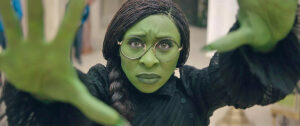 Stephen Schwartz and Gregory Maguire. (I have to confess that I have never seen the stage version.)
Stephen Schwartz and Gregory Maguire. (I have to confess that I have never seen the stage version.)
So what’s not to love about the 160-minute (it seems longer) Wicked movie? Although its co-star, Cynthia Erivo (who plays the green-skinned Elohaba Thropp/Wicked Witch of the West) is a talented singer, there is not one song she sings that is hummable enough to hum—let’s say—in the shower. 1939’s The Wizard of Oz, however, is packed with songs that are still sung today. OK, times have changed over the last 85 years. But Harold Arlen and Yip Harburg (The Wizard of Oz) created wonderful songs with MELODY.
Wicked’s Stephen Schwartz writes songs absent of substantial melody. He has only gotten worse at this since his days of composing music for Godspell and Pippin. Then again, recent Broadway and movie musicals can be accused of the same thing. Alas, the days of memorable songs by Irving Berlin, Cole Porter, and Rodgers & Hammerstein are ancient history.
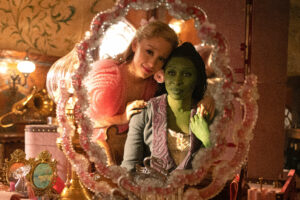
We have what we have now, and are excited to lower the musical bar and jump to a standing ovation. I’m not among that audience, but many/most are. Consider me a grain of salt.
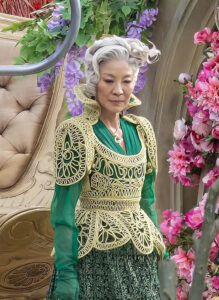 Wicked has zero music and lyrics to even slightly compare with “Over the Rainbow” and “We’re Off to See the Wizard” from The Wizard of Oz.
Wicked has zero music and lyrics to even slightly compare with “Over the Rainbow” and “We’re Off to See the Wizard” from The Wizard of Oz.
My justification for spending so much time criticizing Wicked’s songs is a given: IT’S A MUSICAL! Call me both a fuddy and a duddy.
HOWEVER, there is still much to like about Wicked. The music is passable, but the visuals are awesome. It’s no spoiler to point out that the title itself is a giveaway. Assuming everyone has seen The Wizard of Oz, Wicked centers on the backstory of its scary, green-skinned, magical mistress of evil aka “The Wicked Witch.” HINT: She was not born evil. The story, told through flashbacks within flashbacks, follows the turn in her personality.
That flashback within flashback technique can be off-putting since it is sometimes confusing due to the non-linear storytelling.
 But the cast is stellar. In addition to Erivo, there are Ariana Grande (Glinda), Jonathan Bailey (Fiyero Tigelaar), Ethan Slater (Boq Woodsman), Michelle Yeoh (Madame Morrible), and Jeff Goldblum (The Wonderful Wizard of Oz).
But the cast is stellar. In addition to Erivo, there are Ariana Grande (Glinda), Jonathan Bailey (Fiyero Tigelaar), Ethan Slater (Boq Woodsman), Michelle Yeoh (Madame Morrible), and Jeff Goldblum (The Wonderful Wizard of Oz).
There is also a very cool surprise featuring two cameos by way of Broadway!
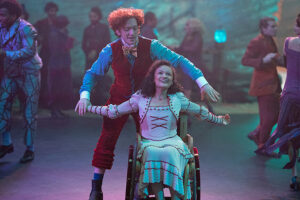 The overall production is glitzy, packed with singers and dancers in wowser costumes, hair and makeup. Set design highlights include the Wizard’s domain plus a training academy reminiscent of Harry Potter’s Hogwarts. (Love that rotating library!)
The overall production is glitzy, packed with singers and dancers in wowser costumes, hair and makeup. Set design highlights include the Wizard’s domain plus a training academy reminiscent of Harry Potter’s Hogwarts. (Love that rotating library!)
Perhaps most of all visual treats, we witness the origin of the evil Flying Monkeys.
Jon M. Chu (Crazy Rich Asians) impressively directs an elephantine production that succeeds despite lacking a score that could have made Wicked memorable for decades—even without Judy Garland.
—————
GRADE on an A-F Scale: B-
__________
The sequel, Wicked: For Good, which will cover the events of the musical’s second act, is scheduled for release on November 21, 2025.
Penny ‘Blondie’ Singleton had well-lived showbiz, service life
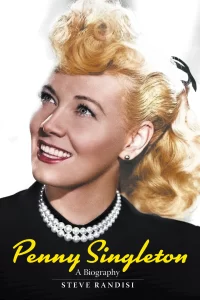 By Steve Crum
By Steve Crum
Had Steve Randisi written a loving book about an actress who appeared in a long-running series of 28 films, that accomplishment alone would be worthy of a major write. But it so happens his fascinating biography of Penny Singleton encompasses an actress, activist, wife and parent who entertained stage, screen, radio and TV audiences…and served as a labor union leader during her 95 years.
Penny Singleton: A Biography is a relatively fast read for its 325 pages, and made informative and interesting by Randisi’s obvious 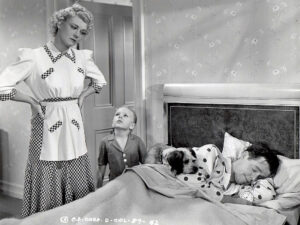 research and adoration of his subject.
research and adoration of his subject.
Born Dorothy McNulty, Penny Singleton (1908-2003) aspired to be an entertainer. Winning the $5 first prize in a Philadelphia amateur talent contest in 1916 did much to encourage the eight year-old. (She sang My Gal Sal.)
From this seemingly Hollywood-movie start through “The Final Years” of the book’s Chapter 22, the book covers her journey from singing at a silent movie theater to singing and dancing in a vaudeville act with none other than Milton Berle, a childhood friend. (By the way, Penny’s dancing style is described as very athletic/gymnastic.) Her play dates rose to parts in Broadway productions and touring in nightclubs and roadshows of plays—akin do what would later be called summer stock.
Randisi’s descriptions of her auditions include her hopes and frustrations. She started getting bit parts in motion pictures, which led to her being cast as Blondie Bumstead (based upon Chic Young’s newspaper comic strip) in the feature comedy, Blondie, in 1938. The low budget programmer was a super hit for Columbia 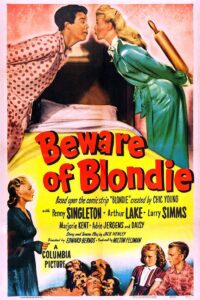 Pictures, which was followed by 27 more Blondie movies co-starring Arthur Lake as Dagwood. The Blondies ended in 1950.
Pictures, which was followed by 27 more Blondie movies co-starring Arthur Lake as Dagwood. The Blondies ended in 1950.
Incidentally, she had long since changed her stage name from Dorothy McNulty. (That interesting factoid is covered in the book as well.)
The second half of her life was filled with more work: a Blondie radio series, her own variety radio program, The Penny Singleton Show, and a fun musical comedy movie, Go West, Young Lady.
The book’s final chapters cover Penny’s leadership as a very vocal and effective President of the American Guild of Variety Artists. 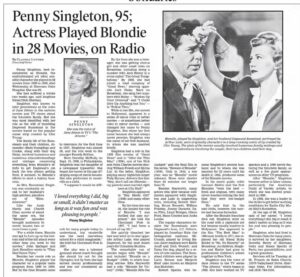 By this time, show business had given way to her union duties as well as her family. (She does return to TV doing voice work in a significant animated series.)
By this time, show business had given way to her union duties as well as her family. (She does return to TV doing voice work in a significant animated series.)
Steve Randisi’s research includes talks he had with Penny decades ago. Interviews with Penny’s family, friends and co-stars help the reader humanize this talented, good-hearted lady.
Let me add how appreciative I am that Steve includes capsule descriptions of the Blondie movies. That alone could have been extended into a second volume.
==========
Penny Singleton: A Biography by Steve Randisi; c. 2024, BearManor Media.
Dystopian ‘Civil War’ is spectacularly ominous
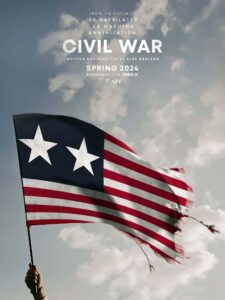 By Steve Crum
By Steve Crum
Alex Garland’s Civil War is described as a “dystopian action thriller,” which it is and maybe isn’t. Being an action thriller is definitely true. The dystopian moniker is iffy because the plot line straddles the line between what is or could be reality and fantasy. For years, there have been suggestions and threats of states seceding and declaring a war against the rest of the United States.
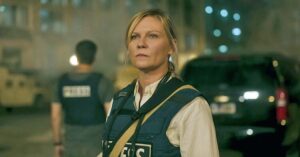 That nightmarish thought is played out in Civil War. Maybe labeling it a dystopian horror story is more apt. Factor in sad, pitiful and disgusting.
That nightmarish thought is played out in Civil War. Maybe labeling it a dystopian horror story is more apt. Factor in sad, pitiful and disgusting.
Don’t get me wrong. The professional quality of the film itself is not sad, pitiful and disgusting. But its representation definitely is such. Alex Garland impressively guides a fine cast (Kirsten Dunst, Wagner Moura, Stephen McKinley Henderson and Cailee Spaeny), cinematographer Rob Hardy, and editor Jake Roberts in this telling of what might happen if.
Crucial to its believability is a heavy reliance on digital special effects and/or AI—if there is indeed a difference.
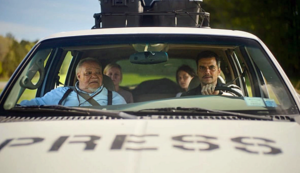 Garland’s story follows a small group of journalists driving across the United States, often through battle zones (tanks, fighter planes, bombs, rifles), to reach their goal of interviewing the controversial President (Nick Offerman) before rebel forces led by California and Texas beat them to our Capitol to kill him. Along the way the four risk their lives by snapping still photos (via 35 mm cameras?) to recount the destruction and body count at ongoing battle sites. (In this sense, the time seems to be set during the 1970s. Otherwise, why don’t they carry video or digital film cameras?)
Garland’s story follows a small group of journalists driving across the United States, often through battle zones (tanks, fighter planes, bombs, rifles), to reach their goal of interviewing the controversial President (Nick Offerman) before rebel forces led by California and Texas beat them to our Capitol to kill him. Along the way the four risk their lives by snapping still photos (via 35 mm cameras?) to recount the destruction and body count at ongoing battle sites. (In this sense, the time seems to be set during the 1970s. Otherwise, why don’t they carry video or digital film cameras?)
 The photojournalists are Lee Smith (Dunst), Joel (Moura), Jessie (Spaeny), and Sammy (Henderson). The four actors do great ensemble work. Throughout most of the literally war-torn journey from New York City to Washington D. C., they travel by well-used car labeled PRESS on its hood. Along the trek, they encounter pockets of individual and group activists from both sides.
The photojournalists are Lee Smith (Dunst), Joel (Moura), Jessie (Spaeny), and Sammy (Henderson). The four actors do great ensemble work. Throughout most of the literally war-torn journey from New York City to Washington D. C., they travel by well-used car labeled PRESS on its hood. Along the trek, they encounter pockets of individual and group activists from both sides.
Particularly jarring is a sequence of a handful of soldiers executing citizens they perceive as enemies, and then dropping their bodies into a mass 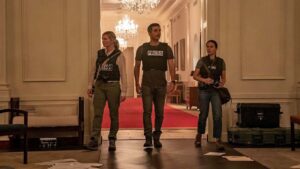 grave. The journalists find themselves directly in the middle of said mess, which escalates into tragedy. (Continued when you see the movie, folks.)
grave. The journalists find themselves directly in the middle of said mess, which escalates into tragedy. (Continued when you see the movie, folks.)
Via the dictionary, “fear, distress, and oppressive societal control” describe dystopian. Strictly speaking then, Civil War fits the grim bill.
—————
GRADE on an A-F Scale: B+
